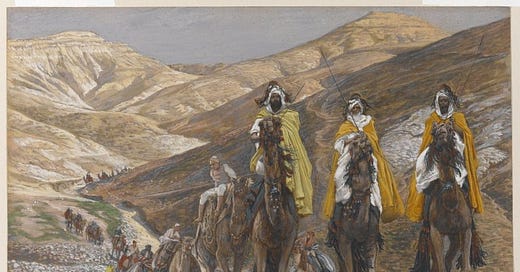Listen as I discuss a few of the theories of the Magi or Wise Men and which one I think fits the biblical story arc best. One of the most popular interpretations is that these are Persian Zoroastrian astrologers, descendants of magi from the time of Jewish exile in Babylon and Daniel’s ascendancy to be a leader among them. Another styles them as Chaldean astrologers from Abraham’s homeland of Mesopotamia (modern day Iraq). There are also some theories of an Ethiopian origin, and the popular names emerging in the 8th century (Balthasar, Melchior and Gaspar) have them coming from several different places (Arabia, India and Persia). Lastly, a theory of Arabian origin, which I outline here, makes the most compelling sense to me.
All of these origin stories have something to offer as we seek to interpret the mysterious magi. They illustrate God is at work among peoples far off, and drawing worshippers from among the nations. They demonstrate that God works through history, over generations and uses even what humanly might be considered failures and disasters to bring about redemption.
I think the most convincing case that demonstrates all of this is the evidence for an Arabian origin of the wise men. The list of evidence is compelling. Matthew 2 says they came from the East (the People of the East were from Arabia), the nature of their gifts (gold and frankincense originates in Arabia), by the story arc or typology (Egypt as protection and Arabia as provision in the stories of Joseph, Moses, Israel and then Jesus) and early church writings.
The earliest church fathers to write about the Magi, Justin Martyr (born 100 AD), Clement of Alexandria (150 AD) and Tertullian (160 AD) all taught the Magi were from Arabia in addition to Martin Luther during the reformation. While other church fathers wrote of Persian origins for example, they came later and may have been influenced by Zoroastrian messianic predictions that emerged somewhere in the 4-6th century.
Then there are the biblical prophecies that speak of Eastern peoples descended from Ishmael. Isaiah 60 and Psalm 72 likely point at the magi visit and the Queen of Sheba’s visit in 1Kings 10 (in a dual fulfillment). Her visit to Solomon pre-figures the magi as she brought similar gifts from modern day Yemen. Notice too how Jesus says in Matt 12:42 “something greater than Solomon is here” in possible reference to the Sheba visit.
Read Isaiah 60:3-7:
Nations will come to your light, and kings to the brightness of your dawn.
Lift up your eyes and look about you: All assemble and come to you; your sons come from afar, and your daughters are carried on the hip. Then you will look and be radiant, your heart will throb and swell with joy; the wealth on the seas will be brought to you, to you the riches of the nations will come.
Herds of camels will cover your land, young camels of Midian and Ephah. And all from Sheba will come, bearing gold and incense and proclaiming the praise of the Lord. All Kedar’s flocks will be gathered to you, the rams of Nebaioth will serve you; they will be accepted as offerings on my altar, and I will adorn my glorious temple.
There’s evidence that a monotheistic Abrahamic faith survived well prior to Islam in Arabia. It is not too far to conjecture that messianic predictions in the Jewish scriptures and prophecies and hope of a future messiah were common knowledge. There were also Jewish communities in these lands. The Eastern desert tribes would have known the faith of their father Abraham and passed it down, they had tons of interaction in the OT with Israel.
I am persuaded that this and several other instances of special favor to Ishmaelite descendants are how God answered Abraham’s prayer in Gen 17 ’That Ishmael might live before you!’ The Angel of the lord visited he and Hagar first, the first recorded names given to God were given by her, possibly the first state visit to Solomon was by an Arabian queen, some of the first besides Mary and Joseph to hear about the incarnation (they would have had to start their journey 3 months perhaps before Jesus’ birth) and the first place Paul went on his missionary endeavors to the Gentiles (Petra/Nabatea).
One scholar goes so far as to say this evidences a soteriological priority for Abraham’s circumcised sons… Israelites, Ishmaelites and then the nations. This pattern follows in church expansion and Paul’s journeys (Galatians). The first purpose built church in the world was also Arabia… in the Nabatean city of Aila (modern day Aqaba).
Overall, this story of the magi illustrates the story arc of the bible… that salvation has come for all peoples. For outcasts, the marginalized and all those who are far off like shepherds and descendants of the banished Ishmael, this story is great news.
For further reading (if you really want to geek-out):
Maalouf, Tony. Arabs in the Shadow of Israel: The Unfolding of God’s Prophetic Plan for Ishmael’s Line. Grand Rapids, MI: Kregel Academic & Professional, 2003. See chapters 12-13 See summaries here https://acts211.org/the-gifts-of-the-magi/ and here https://acts211.org/arab-magi-star-bethlehem/
Harlan, Mark. “The Role of Ishmael in the Divine Drama: Act 2.” ResearchGate. Accessed December 14, 2024. https://www.researchgate.net/publication/379334277_The_Role_of_Ishmael_in_the_Divine_Drama_Act_2. see page 84-86
Martin Hengel, “Paul in Arabia,” Bulletin for Biblical Research 12, no. 1 (2002): 47–66.
Adair, Aaron. “A Critical Look at the History of Interpreting the Star of Bethlehem in Scientific Literature and Biblical Studies.” https://www.academia.edu/30591131/A_Critical_Look_at_the_History_of_Interpreting_the_Star_of_Bethlehem_in_Scientific_Literature_and_Biblical_Studies.
Justin Martyr, "Dialogue with Trypho," Chapters 77 and 78, Ante-Nicene Fathers, edited by A. Roberts and J. Donaldson, New York, Scribners, 1913, vol.1, p.237, Custance, Arthur C. Noah’s Three Sons: Human History in Three Dimensions. First Edition. Grand Rapids, Mich: Zondervan, 1976. https://custance.org/Library/Volume1/index.html#TableofContent%20-%20V1.
Rose, Mark. “Early Church at Aqaba.” Archaeology, Archaeological Institute of America 51, no. 6 (November 1998). https://archive.archaeology.org/9811/newsbriefs/aqaba.html.







Share this post